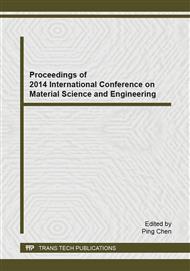[1]
Chen J, Huang S, Lu W. Study on chitosan diguanidinylated coating preservation of longan and its antifungal activities [J]. Science and Technology of Food Industry, 2012, 33(18): 328-331.
Google Scholar
[2]
Zhang Z, Zeng D, Li G. Study of the volatile profile characteristics of longan during storage by a combination sampling method coupled with GC/MS [J]. Journal of the Science of Food and Agriculture, 2008, 88: 1035-1042.
DOI: 10.1002/jsfa.3185
Google Scholar
[3]
Hang D, Cai C, Wu Z. Postharvest physiology and storage property of Dimocarpus longan[J]. Guangdong Agricultural Sciences, 2012, 2: 25-27.
Google Scholar
[4]
Zhang H, Hu W, Pang X. Effect of Ice Temperature Technique and SO2 Releaser on Storage of Longan Fruits [J]. Acta Horticulturae Sinica, 2006, 33(6): 1325-1328.
Google Scholar
[5]
Douglas D. Archbold, Tanachai Pankasemsuk. Effect of hexanal vapour on longan fruit decay, quality and phenolic metabolism during cold storage [J]. International Journal of Food Science and Technology, 2010, 45: 2313-2320.
DOI: 10.1111/j.1365-2621.2010.02401.x
Google Scholar
[6]
Reyhan I Rkin, Metin Guldas. Chitosan coating of red table grapes and fresh-cut honey melons to inhibit Fusarium oxysporum growth [J]. Journal of Food Processing and Preservation, 2013, 17: 1-9.
DOI: 10.1111/jfpp.12170
Google Scholar
[7]
Peerzada R. Hussain, Raghuveer S. Meena, Mohd A. Dar. Carboxymethyl Cellulose Coating and Low-Dose Gamma Irradiation Improves Storage Quality and Shelf Life of Pear[J]. Journal of Food Science, 2010, 75 (9): 586-596.
DOI: 10.1111/j.1750-3841.2010.01868.x
Google Scholar
[8]
Liu J, Li B, Zhu B. Study on Properties and Aggregation Structures of Deacetylated Konjac Glucomannan/Chitosan Hydrochloride Absorbent Blend Gel Films [J]. Journal of Applied Polymer Science, 2009, 115(3): 1503-1509.
DOI: 10.1002/app.31123
Google Scholar
[9]
Kuorwel K. Kuorwel, Marlene J. Cran, Kees Sonneveld. Antimicrobial Activity of Biodegradable Polysaccharide and Protein-Based Films Containing Active Agents [J]. Journal of Food Science, 2011, 76(3): 90-102.
DOI: 10.1111/j.1750-3841.2011.02102.x
Google Scholar
[10]
Liu C, He C and Xie T. Research on Preservation of Synsepalum Dulcificum by Coatings [J]. Advanced Materials Research, 2011, 239-242: 2158-2162.
DOI: 10.4028/www.scientific.net/amr.239-242.2158
Google Scholar
[11]
Kong S, Yuan W, Yu M. Application of edible films in fresh fruit and vegetable[J]. China Food Additives, 2007, 01: 174-177.
Google Scholar


